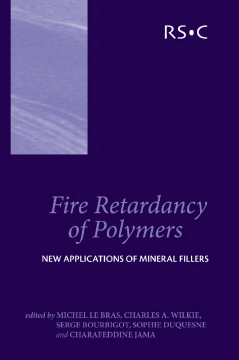
BOOK
Fire Retardancy of Polymers
Peter R Hornsby | Roger N Rothon | Kunihiko Takeda | Christine Pelegris | Takashi Kashiwagi | Sergei Lomakin | Gennady E Zaikov | Jean-Marc Lefebvre | Roman A Sheptalin | Baljinder K Kandola | A Richard Horrocks | Jianqi Wang | Jeffrey W Gilman | Xavier Flambard | Govanni Camino | Bernhard Schartel | Brigitte Mutel | Michel Grisel | Jose M Lopez Cuesta | Luciana De Moura Estevao | Gyorgy Marosi | T Richard Hull | Dennis Price | Pierre Georlette | Michel Le Bras | Serge Bourbigot | Sophie Duquesne | Charafedine Jama | Charles Wilkie
(2007)
Additional Information
Book Details
Abstract
The use of polymers is restricted by their flammability - they may indeed initiate or propagate fire. Fire Retardancy of Polymers focuses on mineral additives from either micro- or nano-composites for application in fire retardants. With the use of fire retardant additives containing halogen or phosphorus compounds in decline, the need for other systems is evident. The major materials that are used are alumina trihydrate or magnesium hydroxide which account for more than 50% by weight of the world-wide sales of fire retardants. Recent works have shown that such halogen-free compounds may give enhanced fire retardancy to polymeric materials when used in low levels, alone, or in synergistic mixtures. The corresponding fire performance depends on the dispersion of the mineral filler, with micrometer-scale dispersion leading to the best performances. Specialists discuss these new applications of mineral fillers with particular emphasis on action mechanisms, new materials including textiles, toxicology and hazards. With extensive references, this book provides a comprehensive and up-to-date view of these applications. This book will appeal to professionals, materials scientists and engineers looking for novel ways to eliminate fire hazards and improve flame retardancy of materials, with a special interest in sustainable development.
